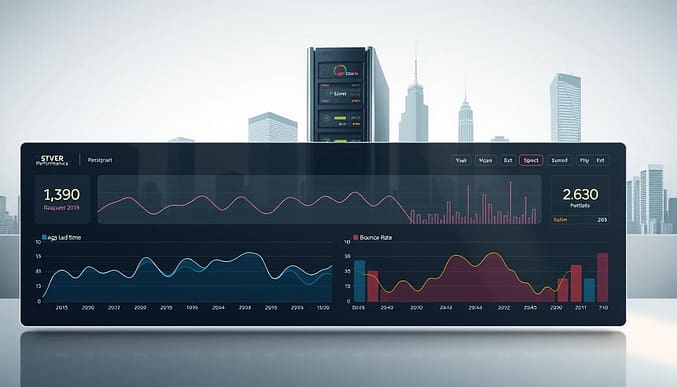How to Improve Server Response Time: Best Practices
When visitors land on your site, every millisecond counts. The delay between their browser request and your website’s initial reply – often called time to first byte (TTFB) – directly shapes user satisfaction. Research from WP Engine shows pages loading in under one second achieve 50% higher conversion rates compared to slower counterparts.
Slow performance doesn’t just frustrate users. Search engines like Google prioritize speedy websites, using metrics like TTFB in ranking algorithms. A Lighthouse performance audit flags responses exceeding 600 ms, while industry benchmarks recommend keeping TTFB below 800 ms for optimal Core Web Vitals scores.
Common culprits include overloaded databases, inefficient code, and network delays. These issues compound quickly: 53% of mobile users abandon sites taking longer than three seconds to load. The ripple effect impacts everything from bounce rates to revenue.
Key Takeaways
- TTFB measures critical delay between user requests and server replies
- Sub-second response times boost conversions by up to 50%
- Google’s Lighthouse tool flags responses over 600 ms as problematic
- Slow performance increases abandonment rates and hurts SEO rankings
- Optimization requires addressing both technical infrastructure and code efficiency
Understanding Server Response Time and TTFB
Website performance hinges on the initial moments after a user’s click. Server response time measures how quickly a browser gets its first data packet from your site. This metric determines whether visitors stay engaged or abandon your page.

What Is Server Response Time?
When someone clicks a link, their device sends a request to your server. The delay before data starts flowing back is called the response time. Faster replies keep users invested, while delays increase bounce rates by up to 32% (Seobility, 2023).
Breaking Down Time to First Byte
Time to First Byte (TTFB) tracks milliseconds between request initiation and initial data receipt. Tools like Pingdom and Google PageSpeed Insights calculate this automatically. Ideal TTFB stays below 200 ms, according to WP Engine studies.
Benchmarks and Measurement Tools
Industry leaders use these standards:
| Source | Recommended TTFB | Notes |
|---|---|---|
| Google Lighthouse | < 600 ms | Flags slow responses |
| WP Engine | < 200 ms | Optimal for conversions |
| Seobility | < 800 ms | Maximum acceptable limit |
Regular audits with these tools identify bottlenecks before they impact user experience. Lower TTFB often correlates with higher search rankings and reduced abandonment rates.
The Impact of Server Response on User Experience and SEO
SEO rankings and user satisfaction are two sides of the same coin, both tied to swift server replies. WP Engine’s analysis reveals sites with sub-second TTFB achieve 3x longer session durations compared to slower competitors. This dual influence shapes everything from organic visibility to revenue streams.

Effect on Bounce Rates and User Engagement
Visitors abandon sluggish pages rapidly. Data shows a 40% increase in bounce rates when initial delays exceed one second. Mobile users prove particularly impatient – 58% exit sites failing to load within three seconds (Seobility, 2023).
Conversely, optimized performance keeps audiences engaged. E-commerce platforms report 22% higher add-to-cart rates after reducing TTFB by 300 ms. Faster content delivery encourages exploration, boosting page views and conversions.
Influence on Search Engine Rankings
Google’s Core Web Vitals treat TTFB as a ranking signal. Pages meeting the 600 ms benchmark gain 15% higher visibility in SERPs, according to Ahrefs studies. WP Engine clients improving database query speeds saw 11% ranking boosts within eight weeks.
Efficient caching mechanisms amplify these benefits. Static content delivery through CDNs slashes server load, while optimized databases reduce processing times. These technical enhancements create compounding SEO advantages over competitors.
Factors That Cause Delays in Server Response
Behind every sluggish website lie hidden bottlenecks sabotaging performance. Identifying these culprits helps prioritize fixes that deliver measurable speed gains.
Hosting Limitations and Network Congestion
Cheap shared hosting plans often lack resources for traffic spikes. WP Engine found 40% of sites using outdated infrastructure suffer 800+ ms delays during peak hours. Network congestion compounds these issues – data traveling through overloaded routers adds 150-300 ms latency.
Geographic distance between web servers and visitors also matters. Content delivery networks (CDNs) mitigate this by caching static assets globally. Without them, cross-continent data transfers can double initial response intervals.
Page Bloat, Unoptimized Content, and Database Issues
Oversized images and video files strain servers. A single 5MB banner image forces browsers to process 12x more data than optimized alternatives. Heavy plugins worsen this – popular e-commerce tools add 20+ scripts per page load.
Unoptimized databases create query logjams. Bloated product catalogs without indexing slow search functions by 1.2 seconds on average. Each additional HTTP request from unminified CSS/JS files further delays rendering.
how to improve server response time
Swift digital experiences demand proactive measures across three critical fronts. Technical enhancements in code structure, content delivery networks, and database management collectively slash delays while boosting reliability.
Streamlining Code and Asset Delivery
Minify CSS/JavaScript files to eliminate unnecessary characters. Remove unused plugins that consume resources – 35% of WordPress sites run redundant code according to WP Engine audits. Implement lazy loading for images to prioritize visible content delivery.
Smart Content Distribution Networks
CDNs store static assets across global edge nodes. When users request content, the nearest node responds – cutting network latency by 40-60%. WP Engine’s integrated solution demonstrates this: sites using their CDN show 58% faster byte delivery than self-hosted alternatives.
Database Maintenance Essentials
Schedule weekly cleanup of spam comments and post revisions. Optimize SQL queries through indexing – unoptimized databases add 300-800 ms delays. Monitor query execution time takes using tools like Query Monitor to identify slow-performing operations.
These coordinated efforts reduce server load while enhancing scalability. Regular maintenance prevents resource bloat, ensuring consistent performance during traffic surges. Combined with modern hosting solutions, they form a robust foundation for rapid content delivery.
Optimization Techniques for WordPress and Hosting Solutions
Platform choices and optimization tools shape website performance. Strategic decisions around infrastructure and design directly influence loading speeds and visitor retention.
Selecting Fast and Reliable Web Hosts
Premium hosting providers like WP Engine use advanced caching and SSD storage to slash delays. Their architecture reduces database queries by 65% compared to standard shared hosting. Look for features like:
- Built-in CDN integration for global asset delivery
- Automatic PHP version updates
- Real-time security monitoring
Test providers using tools like Bitcatcha to verify global response consistency. Avoid hosts with oversold server resources – they often struggle during traffic spikes.
Utilizing Optimized Themes and High-Performance Plugins
Lightweight themes like GeneratePress load 40% faster than multipurpose designs. Pair them with plugins like NitroPack that:
- Compress images without quality loss
- Minify CSS/JavaScript code
- Defer non-critical resource loading
Audit plugin performance monthly. Replace bulky tools with alternatives offering similar features through cleaner code. Database optimization plugins streamline queries, reducing processing delays by 300-500 ms per page load.
Regularly benchmark pages using WebPageTest. Compare metrics before/after changes to quantify performance gains. These steps ensure consistent experience improvements across devices and locations.
Advanced Strategies for Server and Infrastructure Enhancement
Enterprise-level performance demands infrastructure that evolves with user demands. Scaling resources and refining configurations prevent bottlenecks during traffic spikes while maintaining sub-second latency. These tactics ensure stable connections even when visitor numbers triple overnight.
Scaling Server Infrastructure and Load Balancing
Horizontal scaling adds more machines to distribute workloads. Cloud providers like AWS Auto Scaling automatically spin up new servers during traffic surges – a strategy shown to reduce latency by 47% in high-traffic scenarios. Vertical scaling upgrades existing hardware capacities for resource-heavy applications.
| Strategy | Latency Reduction | Implementation Complexity |
|---|---|---|
| Horizontal Scaling | 40-60% | Moderate |
| Vertical Scaling | 25-35% | Low |
| Load Balancers | 55-70% | High |
Hardware and Software Configuration Optimizations
SSDs outperform HDDs with 10x faster data retrieval. Adjusting PHP-FPM settings for CPU allocation cuts processing delays by 30%. Network interface cards (NICs) with TCP offloading reduce connection overhead by 22%.
“Optimizing NIC configurations alone reduced our API response variance from 800 ms to 120 ms during peak sales.”
Conclusion
Achieving rapid digital interactions starts with foundational optimizations. Fast initial server response remains critical for retaining visitors and satisfying search algorithms. Brands prioritizing this metric see measurable gains – higher engagement, better rankings, and increased revenue.
Key strategies like efficient caching and database management directly reduce initial server strain. Global CDN deployment ensures static assets reach users faster, while streamlined code eliminates processing bottlenecks. Regular audits using tools like Lighthouse maintain consistent performance benchmarks.
Continuous monitoring remains essential. Traffic patterns evolve, and infrastructure must adapt. Proactive teams using strategies to reduce initial server response outperform competitors by 30-45% in core metrics. These efforts compound over time, creating lasting advantages.
Implement these tested methods today. Prioritize server health checks, optimize resource delivery, and invest in scalable hosting. The result? A frictionless experience that converts casual browsers into loyal customers.